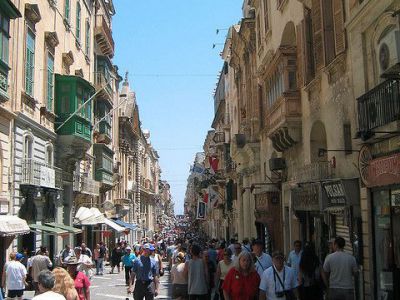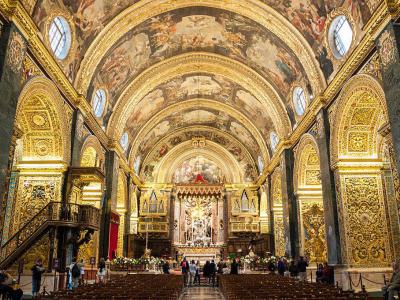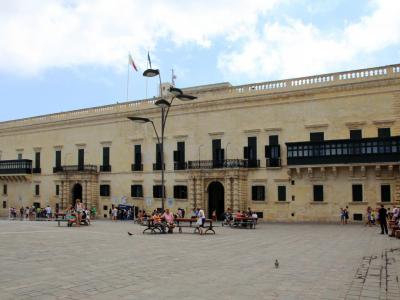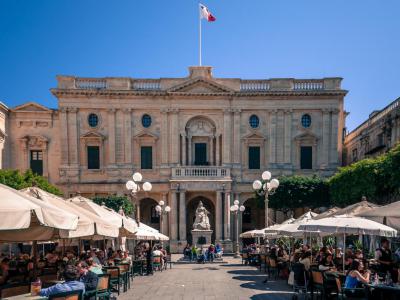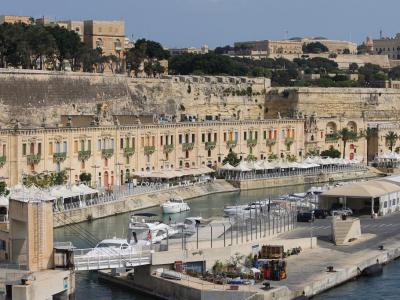Custom Walk in Valletta, Malta by richardokeefe_c26b2 created on 2025-07-04
Guide Location: Malta » Valletta
Guide Type: Custom Walk
# of Sights: 5
Tour Duration: 1 Hour(s)
Travel Distance: 1.9 Km or 1.2 Miles
Share Key: XJKXP
Guide Type: Custom Walk
# of Sights: 5
Tour Duration: 1 Hour(s)
Travel Distance: 1.9 Km or 1.2 Miles
Share Key: XJKXP
How It Works
Please retrieve this walk in the GPSmyCity app. Once done, the app will guide you from one tour stop to the next as if you had a personal tour guide. If you created the walk on this website or come to the page via a link, please follow the instructions below to retrieve the walk in the app.
Retrieve This Walk in App
Step 1. Download the app "GPSmyCity: Walks in 1K+ Cities" on Apple App Store or Google Play Store.
Step 2. In the GPSmyCity app, download(or launch) the guide "Valletta Map and Walking Tours".
Step 3. Tap the menu button located at upper right corner of the "Walks" screen and select "Retrieve custom walk". Enter the share key: XJKXP
1) Republic Street
Republic Street is the main artery of Valletta and the center of the capital’s administrative life. Stretching for just one kilometer, it runs straight from City Gate to the granaries beside Fort Saint Elmo, forming the backbone of the city’s grid. Today it is primarily pedestrian, making it an easy and enjoyable place to explore on foot.
As you walk along Republic Street, you will see many of Malta’s key institutions and landmarks. You will pass the modern Parliament of Malta near the entrance, followed by the Courts of Justice and the Grand Master’s Palace further along. The street also intersects several important squares, each offering different views of Valletta’s government buildings, churches, cafés, and small museums.
Down the street, you will find yourself moving through centuries of Maltese history. Don’t miss the traditional shopfronts and the contrast between older limestone facades and recent restorations. This is one of the best places to watch daily life unfold—office workers, shoppers, and visitors all sharing the same historic path.
Republic Street has carried many names. Laid out soon after the Great Siege of 1565, it was originally called San Giorgio Street. Under French rule it became National Street, followed by Royal Road during the early British period. In 1936 it was renamed Kingsway, a name many older residents still remember. After independence, it received its present name: Republic Street.
Bombed during World War II and later rebuilt, the street remains the heart of Valletta—busy, historic, and central to understanding the city.
As you walk along Republic Street, you will see many of Malta’s key institutions and landmarks. You will pass the modern Parliament of Malta near the entrance, followed by the Courts of Justice and the Grand Master’s Palace further along. The street also intersects several important squares, each offering different views of Valletta’s government buildings, churches, cafés, and small museums.
Down the street, you will find yourself moving through centuries of Maltese history. Don’t miss the traditional shopfronts and the contrast between older limestone facades and recent restorations. This is one of the best places to watch daily life unfold—office workers, shoppers, and visitors all sharing the same historic path.
Republic Street has carried many names. Laid out soon after the Great Siege of 1565, it was originally called San Giorgio Street. Under French rule it became National Street, followed by Royal Road during the early British period. In 1936 it was renamed Kingsway, a name many older residents still remember. After independence, it received its present name: Republic Street.
Bombed during World War II and later rebuilt, the street remains the heart of Valletta—busy, historic, and central to understanding the city.
2) St. John's Co-Cathedral (must see)
Saint John's Co-Cathedral in Valletta represents the rich heritage of the Knights of Malta. Commissioned in 1572 by Grand Master Jean de la Cassière and completed just a few years later, it served as the conventual church of the Order of Saint John. The design was entrusted to Glormu Cassar, the Maltese architect responsible for many of Valletta’s early buildings.
From the outside, the cathedral has a plain, fortress-like appearance—a reminder that it was built shortly after the Great Siege of 1565, during a time when defense shaped every corner of the new capital. The simplicity of the façade prepares visitors for the dramatic contrast they will encounter inside.
Once inside, you enter a very different world. Richly decorated walls are carved directly into the stone, and painted scenes from the life of Saint John by 17th-century Italian Baroque artist Mattia Preti cover the interior. Don’t miss the ceiling: Preti’s use of light and shadow makes some figures appear almost to lift off the surface. One of the most remarkable features is that the elaborate carvings were created directly on the walls, rather than being added later.
Make your way to the Oratory, located just beyond the right-hand side chapels. Here you’ll find Caravaggio’s The Beheading of Saint John the Baptist, the cathedral’s best-known masterpiece and the only painting he ever signed. The vast canvas fills nearly an entire wall and is a striking example of his dramatic use of light and shadow. In the same space, look for his smaller work, Saint Jerome Writing, which is equally compelling.
Before leaving, pause in the Nave, where about 400 inlaid marble tombstones form a colorful, detailed floor. Each tombstone marks the final resting place of a knight of the Order of St. John and is decorated with heraldic symbols, coats of arms, and carvings highlighting the knight’s rank, achievements, and virtues. Many include allegorical figures, religious motifs, and inscriptions about their lives. The vibrant marbles, ranging from deep reds to soft whites and greens, create a mosaic-like effect across the cathedral’s nave and chapels.
Tip:
Get there early! This is a very popular attraction and the groups and cruise ship passengers descend by 10:30 or so.
From the outside, the cathedral has a plain, fortress-like appearance—a reminder that it was built shortly after the Great Siege of 1565, during a time when defense shaped every corner of the new capital. The simplicity of the façade prepares visitors for the dramatic contrast they will encounter inside.
Once inside, you enter a very different world. Richly decorated walls are carved directly into the stone, and painted scenes from the life of Saint John by 17th-century Italian Baroque artist Mattia Preti cover the interior. Don’t miss the ceiling: Preti’s use of light and shadow makes some figures appear almost to lift off the surface. One of the most remarkable features is that the elaborate carvings were created directly on the walls, rather than being added later.
Make your way to the Oratory, located just beyond the right-hand side chapels. Here you’ll find Caravaggio’s The Beheading of Saint John the Baptist, the cathedral’s best-known masterpiece and the only painting he ever signed. The vast canvas fills nearly an entire wall and is a striking example of his dramatic use of light and shadow. In the same space, look for his smaller work, Saint Jerome Writing, which is equally compelling.
Before leaving, pause in the Nave, where about 400 inlaid marble tombstones form a colorful, detailed floor. Each tombstone marks the final resting place of a knight of the Order of St. John and is decorated with heraldic symbols, coats of arms, and carvings highlighting the knight’s rank, achievements, and virtues. Many include allegorical figures, religious motifs, and inscriptions about their lives. The vibrant marbles, ranging from deep reds to soft whites and greens, create a mosaic-like effect across the cathedral’s nave and chapels.
Tip:
Get there early! This is a very popular attraction and the groups and cruise ship passengers descend by 10:30 or so.
3) Grandmaster's Palace and Armoury (must see)
The Grandmaster’s Palace, often simply called The Palace, is one of Valletta’s most historically significant buildings. Built between the 16th and 18th centuries, it served as the residence of the Grand Master of the Order of Saint John and later became the Governor’s Palace under British rule. Today, it houses the Office of the President of Malta, while selected areas—such as the Palace State Rooms and the Palace Armory—are open to visitors through Heritage Malta.
As you approach the building, you will see its Mannerist façade, designed with a focus on balance and restraint. The front is noticeably asymmetrical, reflecting centuries of alterations. Two arched entrances lead toward an upper balcony, and you will find traditional closed timber balconies at the corners—features added during the 18th century. Originally, the exterior was coated in red ochre, a color used by the Order to mark official buildings.
Inside, don’t miss the Palace Armory, open to the public since 1860. This collection once equipped the Knights of Saint John during the 17th and 18th centuries and remains one of the largest armories displayed in its original setting.
The palace is organized around two courtyards, with one featuring a Neptune statue. The collection ranges from actual armor worn in battles on Maltese soil against Arab or Byzantine forces to swords and cannons, offering a vivid journey through history.
Tip:
The armory can also be visited on a joint ticket with the nearby Palace State Rooms, which are full of history and beautiful to look at. To get to the rooms, there are four flights of stairs or a lift to take.
As you approach the building, you will see its Mannerist façade, designed with a focus on balance and restraint. The front is noticeably asymmetrical, reflecting centuries of alterations. Two arched entrances lead toward an upper balcony, and you will find traditional closed timber balconies at the corners—features added during the 18th century. Originally, the exterior was coated in red ochre, a color used by the Order to mark official buildings.
Inside, don’t miss the Palace Armory, open to the public since 1860. This collection once equipped the Knights of Saint John during the 17th and 18th centuries and remains one of the largest armories displayed in its original setting.
The palace is organized around two courtyards, with one featuring a Neptune statue. The collection ranges from actual armor worn in battles on Maltese soil against Arab or Byzantine forces to swords and cannons, offering a vivid journey through history.
Tip:
The armory can also be visited on a joint ticket with the nearby Palace State Rooms, which are full of history and beautiful to look at. To get to the rooms, there are four flights of stairs or a lift to take.
4) Republic Square
Initially known as Treasury Square due to its hosting of the Order of Saint John's treasury, this area was later renamed Queen's Square after a statue of Queen Victoria was placed there during the British era. Nowadays, it's officially called Republic Square, but many people still refer to it as Queen's Square.
On the northwest side, you'll find a significant building, the Common Treasure House, which stored important documents and financial records for the Order of Saint John. Over time, this building has served various purposes, including government offices, a hotel, and a cinema. It suffered damage during World War II but was repaired and is now the Casino Maltese, with cafes and shops occupying the ground level. One notable spot here is Cafe Cordina - one of Malta’s most historic cafés and a longtime gathering place for locals, artists, writers, and politicians.
The southeast side faces the National Library of Malta, a necessity for more space for the Order's growing collection of books. Designed by Stefano Ittar, a Polish-Italian architect, the library was completed in 1796.
The square's northeast side is next to the Grandmaster's Palace, the official residence of Malta's ruler, while the southwest side features a shopping arcade. Today, the square is a lively area with outdoor cafes and restaurants.
On the northwest side, you'll find a significant building, the Common Treasure House, which stored important documents and financial records for the Order of Saint John. Over time, this building has served various purposes, including government offices, a hotel, and a cinema. It suffered damage during World War II but was repaired and is now the Casino Maltese, with cafes and shops occupying the ground level. One notable spot here is Cafe Cordina - one of Malta’s most historic cafés and a longtime gathering place for locals, artists, writers, and politicians.
The southeast side faces the National Library of Malta, a necessity for more space for the Order's growing collection of books. Designed by Stefano Ittar, a Polish-Italian architect, the library was completed in 1796.
The square's northeast side is next to the Grandmaster's Palace, the official residence of Malta's ruler, while the southwest side features a shopping arcade. Today, the square is a lively area with outdoor cafes and restaurants.
5) Valletta Waterfront (must see)
The Valletta Waterfront, located in Floriana, is a picturesque promenade distinguished by three notable buildings: a centrally positioned Church of the Flight into Egypt, the Pinto Stores (also known as the Pinto Wharf) to the left, and the Forni Stores (or Forni Shopping Complex) to the right.
Originally established in July 1727 by Grand Master Anton Manuel de Vilhena, the Valletta Marina underwent subsequent development in 1752 under the direction of Grandmaster Manuel Pinto de Fonseca. This expansion saw the addition of 19 impressive stores and a church, all designed in the Baroque style attributed to Andrea Belli.
During World War II, the area suffered significant damage from aerial bombardment due to its proximity to the Malta Dockyard and British naval forces in Grand Harbour. However, extensive restoration efforts were undertaken post-war to revive and enhance the waterfront.
Today, management of the Valletta Waterfront falls under a private consortium, overseeing Malta's cruise liner operations. The waterfront boasts approximately twelve restaurants, several bars, and retail outlets. It serves as a venue for various events, including the Malta Jazz Festival and the Malta Fireworks Festival.
The Church of the Flight into Egypt, constructed in 1752 alongside the stores, endured bombing during World War II. However, damaged portions were faithfully reconstructed to match the original design, with restored original elements. Mass is conducted at the church every Saturday evening. Additionally, a bronze image of Jesus's face, originally affixed to the church, now adorns the facade of the Co-Cathedral of Saint John in Valletta.
Recognized for their historical significance, the Pinto Stores were designated as a grade 1 national monument and listed on the National Inventory of the Cultural Property of the Maltese Islands (NICPMI), having been included on the Antiquities List of 1925.
Originally established in July 1727 by Grand Master Anton Manuel de Vilhena, the Valletta Marina underwent subsequent development in 1752 under the direction of Grandmaster Manuel Pinto de Fonseca. This expansion saw the addition of 19 impressive stores and a church, all designed in the Baroque style attributed to Andrea Belli.
During World War II, the area suffered significant damage from aerial bombardment due to its proximity to the Malta Dockyard and British naval forces in Grand Harbour. However, extensive restoration efforts were undertaken post-war to revive and enhance the waterfront.
Today, management of the Valletta Waterfront falls under a private consortium, overseeing Malta's cruise liner operations. The waterfront boasts approximately twelve restaurants, several bars, and retail outlets. It serves as a venue for various events, including the Malta Jazz Festival and the Malta Fireworks Festival.
The Church of the Flight into Egypt, constructed in 1752 alongside the stores, endured bombing during World War II. However, damaged portions were faithfully reconstructed to match the original design, with restored original elements. Mass is conducted at the church every Saturday evening. Additionally, a bronze image of Jesus's face, originally affixed to the church, now adorns the facade of the Co-Cathedral of Saint John in Valletta.
Recognized for their historical significance, the Pinto Stores were designated as a grade 1 national monument and listed on the National Inventory of the Cultural Property of the Maltese Islands (NICPMI), having been included on the Antiquities List of 1925.
